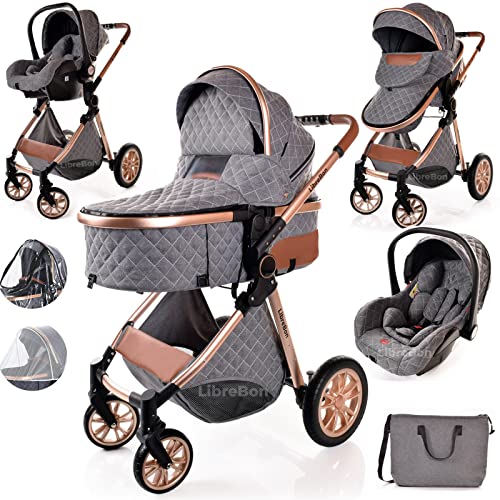Understanding Baby Prams and Pushchairs: A Comprehensive Guide
When it concerns looking after a newborn or an infant, couple of items are as necessary as a trustworthy baby pram or pushchair. These movement help provide a safe, comfortable method to transport babies while permitting parents and caretakers the flexibility to browse the world. This article checks out the various elements of baby prams and pushchairs, helping moms and dads make informed choices about which product might be best suited for their family's requirements.
What Are Baby Prams and Pushchairs?
Baby Prams: These are generally designed for infants and extremely young babies. They have fully reclining seats that permit a flat position, making them ideal for newborns. Prams typically feature a big, deep body, supplying extra protection and comfort.
Pushchairs: Pushchairs, also referred to as strollers, are more flexible and can generally be adjusted for toddlers too. They are lightweight, easy to steer, and often feature a range of seating positions, including reclined and upright.
| Function | Baby Prams | Pushchairs |
|---|---|---|
| Suitable Age | Newborn to around 6 months | Newborn to 3 years or more |
| Seat Position | Completely reclined | Adjustable (reclined and upright) |
| Weight | Much heavier, more robust | Lighter, more compact |
| Folding Mechanism | More complicated folding | Usually easier folding |
| Maneuverability | Can be less maneuverable | Extremely maneuverable |
Secret Features to Consider
When choosing a baby pram or pushchair, potential purchasers need to consider numerous crucial functions that can affect the functionality and convenience for both the child and the caregiver.
1. Security Features
- Five-point Harness: Ensures the baby is securely strapped in.
- Brakes: Reliable braking systems prevent accidents.
- Stability: A large base and sound frame improve stability.
2. Convenience
- Padding: Ample cushioning on the seat ensures convenience.
- Suspension System: Provides a smoother ride on uneven surface areas.
- Canopy: A large, adjustable canopy protects the baby from sun and rain.
3. Mobility
- Weight: Lighter designs are much easier to raise and bring.
- Folding Mechanism: Easy folding designs permit quick storage and transport.
- Compact Size: A more compact size makes it simpler to fit into car boots and tight spaces.
4. Versatility
- Convertible Options: Some models can be changed from a pram to a pushchair.
- Reversible Seat: Allows the baby to deal with the parent or the world, depending on choice.
- Devices: Look for alternatives that can accommodate automobile seats or have a storage basket.
5. Toughness
- Product Quality: Invest in higher-end materials for longevity.
- Weather condition Resistance: Water-resistant materials ensure that the pram/pushchair can endure numerous weather conditions.
Kinds Of Baby Prams and Pushchairs
Numerous kinds of baby prams and pushchairs fulfill different function requirements, aligning with parents' specific lifestyles.
1. Travel Systems
Travel systems normally integrate a safety seat and a stroller in one bundle, permitting seamless transport from vehicle to pram or pushchair without disturbing the baby.
2. Umbrella Strollers
Umbrella strollers are light-weight and convenient, created for much easier maneuverability. They are perfect for quick journeys and might lack some features discovered in full-size strollers.
3. All-Terrain Pushchairs
These are perfect for active families who delight in treking or taking strolls on rugged terrains. They normally come with bigger wheels for stability.
4. Jogging Strollers
Jogging strollers are created for parents who want to integrate exercise with childcare. They feature durable frames and repaired front wheels to improve security during a run.
The Importance of Choosing the Right Option
Choosing the appropriate baby pram or pushchair is not simply a matter of choice; it directly affects the safety and convenience of the baby. Moreover, the best choice can profoundly affect the lifestyle of the caretakers.
Advantages:
- Convenience: A well-chosen pram or pushchair makes getaways simpler and more satisfying.
- Health: Proper assistance helps in back and skeletal advancement in babies.
- Bonding: Outdoors play a vital role in parent-child bonding.
Often Asked Questions (FAQs)
1. At what age can my baby use a pushchair?
A lot of pushchairs are designed to accommodate babies as young as six months, although some designs can be gotten used to securely transport newborns when used with suitable car seats.
2. How do Prams Online preserve my baby pram or pushchair?
Routine cleaning is necessary. Clean down the frame and fabric with a damp cloth and moderate soap. Occasionally inspect the wheels and brakes for wear and tear.
3. Can I use a baby pram for jogging?
Typically, no. Routine baby prams do not have the stability and design needed for jogging. It is much safer to use a stroller specifically created for that purpose.
4. How do I choose the ideal size?
Think about how often you will be utilizing the pram/pushchair and where. If area is restricted, look for a more compact design. For outside experiences, select one with bigger wheels and good suspension.
Baby prams and pushchairs are important tools for parents and caregivers, enabling safe and comfortable transport of babies and young children. By understanding learn here , types, and benefits involved, caregivers can pick the very best movement aid matched to their requirements. Whether it be a sophisticated travel system or a simple umbrella stroller, the right purchase can substantially enhance the experience of parenthood, making outings pleasurable and hassle-free for both moms and dads and babies alike.

